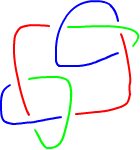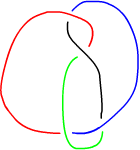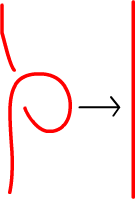
Tricolorability
Encyclopedia
In the mathematical
field of knot theory
, the tricolorability of a knot
is the ability of a knot to be colored with three colors subject to certain rules. Tricolorability is an isotopy invariant, and hence can be used to distinguish between two different (non-isotopic) knots. In particular, since the unknot
is not tricolorable, any tricolorable knot is necessarily nontrivial.
a knot in accordance of the rules of tricolorability. By convention, knot theorists use the colors red, green, and blue.

The granny knot
is tricolorable. In this coloring the three strands at every crossing have three different colors. Coloring one but not both of the trefoil knot
s all red would also give an admissible coloring.

The figure eight knot is NOT tricolorable. Looking at the figure with three of the strands coloured, one can see there is a dilemma: all three crossings involving the black strand need a different color to complete its tricoloring. The top crossing needs a green strand, the middle crossing needs a blue strand and the bottom crossing needs a red strand. There is no way to colour two of the colored strands the same to avoid problems either. Since one cannot color this knot in accordance with the rules of tricolorability, it is considered NOT tricolorable.
that remains constant regardless of any ambient isotopy
. This can be proven by examining Reidemeister move
s. Since each Reidemeister move can be made without affecting tricolorability, tricolorability is an isotopy invariant.
Mathematics
Mathematics is the study of quantity, space, structure, and change. Mathematicians seek out patterns and formulate new conjectures. Mathematicians resolve the truth or falsity of conjectures by mathematical proofs, which are arguments sufficient to convince other mathematicians of their validity...
field of knot theory
Knot theory
In topology, knot theory is the study of mathematical knots. While inspired by knots which appear in daily life in shoelaces and rope, a mathematician's knot differs in that the ends are joined together so that it cannot be undone. In precise mathematical language, a knot is an embedding of a...
, the tricolorability of a knot
Knot
A knot is a method of fastening or securing linear material such as rope by tying or interweaving. It may consist of a length of one or several segments of rope, string, webbing, twine, strap, or even chain interwoven such that the line can bind to itself or to some other object—the "load"...
is the ability of a knot to be colored with three colors subject to certain rules. Tricolorability is an isotopy invariant, and hence can be used to distinguish between two different (non-isotopic) knots. In particular, since the unknot
Unknot
The unknot arises in the mathematical theory of knots. Intuitively, the unknot is a closed loop of rope without a knot in it. A knot theorist would describe the unknot as an image of any embedding that can be deformed, i.e. ambient-isotoped, to the standard unknot, i.e. the embedding of the...
is not tricolorable, any tricolorable knot is necessarily nontrivial.
Rules of tricolorability
A knot is tricolorable if each strand of the knot diagram can be colored one of three colors, subject to the following rules:- 1. At least two colors must be used, and
- 2. At each crossing, the three incident strands are either all the same color or all different colors.
Examples
Here is an example of how to colorColor
Color or colour is the visual perceptual property corresponding in humans to the categories called red, green, blue and others. Color derives from the spectrum of light interacting in the eye with the spectral sensitivities of the light receptors...
a knot in accordance of the rules of tricolorability. By convention, knot theorists use the colors red, green, and blue.
Example of a tricolorable knot

The granny knot
Granny knot
The granny knot is a binding knot, used to secure a rope or line around an object. It is considered inferior to the reef knot, which it superficially resembles. Neither of these knots should be used as a bend for attaching two ropes together....
is tricolorable. In this coloring the three strands at every crossing have three different colors. Coloring one but not both of the trefoil knot
Trefoil knot
In topology, a branch of mathematics, the trefoil knot is the simplest example of a nontrivial knot. The trefoil can be obtained by joining together the two loose ends of a common overhand knot, resulting in a knotted loop...
s all red would also give an admissible coloring.
Example of a non-tricolorable knot

The figure eight knot is NOT tricolorable. Looking at the figure with three of the strands coloured, one can see there is a dilemma: all three crossings involving the black strand need a different color to complete its tricoloring. The top crossing needs a green strand, the middle crossing needs a blue strand and the bottom crossing needs a red strand. There is no way to colour two of the colored strands the same to avoid problems either. Since one cannot color this knot in accordance with the rules of tricolorability, it is considered NOT tricolorable.
Isotopy invariant
Tricolorability is an isotopy invariant, which is a property of a knot or linkLink (knot theory)
In mathematics, a link is a collection of knots which do not intersect, but which may be linked together. A knot can be described as a link with one component. Links and knots are studied in a branch of mathematics called knot theory...
that remains constant regardless of any ambient isotopy
Ambient isotopy
In the mathematical subject of topology, an ambient isotopy, also called an h-isotopy, is a kind of continuous distortion of an "ambient space", a manifold, taking a submanifold to another submanifold. For example in knot theory, one considers two knots the same if one can distort one knot into the...
. This can be proven by examining Reidemeister move
Reidemeister move
In the mathematical area of knot theory, a Reidemeister move refers to one of three local moves on a link diagram. In 1926, Kurt Reidemeister and independently, in 1927, J.W. Alexander and G.B...
s. Since each Reidemeister move can be made without affecting tricolorability, tricolorability is an isotopy invariant.
| Reidemeister Move I is tricolorable. | Reidemeister Move II is tricolorable. | Reidemeister Move III is tricolorable. |
|---|---|---|
 |

